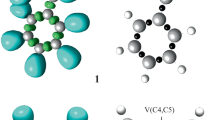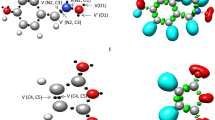Abstract
A molecular electron density theory study is presented for [3 + 2] cycloaddition (32CA) reactions of 2,2-dimethyl-1-pyrroline-1-oxide with the nitrile functions to analyse the mechanism and experimentally observed regioselectivity. Electron localisation function (ELF) study predicts zwitter-ionic character of the cyclic nitrone, allowing its participation in zw-type 32CA reactions associated with high energy barrier demanding overcome through appropriate electrophilic–nucleophilic interactions. Analysis of the CDFT indices predict the global electronic flux from the strong nucleophilic nitrone to the electrophilic nitrile functions. These 32CA reactions are endergonic with reactions Gibbs free energies between 5.5 and 39.2 \(\text{kcal}{\cdot}\text{mol}^{-1}\) in toluene. The ortho regiochemical pathway is preferred owing to the higher thermodynamic stability of the 2,3-dihydro-1,2,4-oxadiazole derivatives. The 32CA reaction of the nitrile function with carbomethoxy substituent is more facile relative to that with the phenyl substituent. Bonding evolution theory study predicts one-step mechanism with early TSs for the ortho pathway, while a one-step-two-stage mechanism is predicted for the meta reaction path, in conformity with the ELF and AIM topological studies at the TSs.











Similar content being viewed by others
References
Plate R, Hermkens PHH, Smits JMM, Nivard RJF, Ottenheijm HCJ (1987) Employment of nitriles in the stereoselective cycloaddition to nitrones. J Organ Chem 52(6):1047–1051. https://doi.org/10.1021/jo00382a014
Hermkens PHH, Maarseveen JHV, Kruse CG, Scheeren HW (1988) 1,3-Dipolar cycloaddition of nitrones with nitriles: scope and mechanistic study. Tetrahedron 44(20):6491–6504. https://doi.org/10.1016/S0040-4020(01)89838-0
Bokach NA, Kukushkin VY (2006) 1,3-dipolar cycloaddition of nitrones to free and coordinated nitriles: routes to control the synthesis of 2,3-dihydro-1,2,4-oxadiazoles. Russ Chem Bull 55(11):1869–1882. https://doi.org/10.1007/s11172-006-0528-0
Bokach NA, Kuznetsov ML, Kukushkin VY (2011) 1,3-Dipolar cycloaddition of nitrone-type dipoles to uncomplexed and metal-bound substrates bearing the CN triple bond. Coord Chem Rev 255(23):2946–2967. https://doi.org/10.1016/j.ccr.2011.07.001
Yu Y, Watanabe N, Ohno M, Eguchi S (1995) Synthesis of novel carbo- and heteropolycycles. Part 30. 1,3-Dipolar cycloaddition of nitrile functions with some selected nitrones. Efficient synthesis of 2,3-dihydro-1,2,4-oxadiazole derivatives. J Chem Soc Perkin Trans 1(11):1417–1421. https://doi.org/10.1039/P19950001417
Yu Y, Fujita H, Ohno M, Eguchi S (1995) 1,3-Dipolar cycloaddition of nitrile functions with nitrones under high pressure conditions. A new and direct synthesis of 2,3-Dihydro-1,2,4-Oxadiazole derivatives. Synthesis 05:498–500. https://doi.org/10.1055/s-1995-3949
Yu Y, Ohno M, Eguchi S (1994) Remarkable dipolarophilicity of nitrile function uncovered in the 1,3-dipolar cycloaddition reaction of homoadamantane-incorporated nitrones. A direct and facile route to Δ4-1,2,4-oxadiazoline (2,3-dihydro-1,2,4-oxadiazole) derivatives. J Chem Soc Chem Commun 3:331–332. https://doi.org/10.1039/C39940000331
Krylov A, Windus TL, Barnes T, Marin-Rimoldi E, Nash JA, Pritchard B, Smith DGA, Altarawy D, Saxe P, Clementi C, Crawford TD, Harrison RJ, Jha S, Pande VS, Head-Gordon T (2018) Perspective: computational chemistry software and its advancement as illustrated through three grand challenge cases for molecular science. J Chem Phys 149(18):180901. https://doi.org/10.1063/1.5052551
Domingo LR (2016) Molecular electron density theory: a modern view of reactivity in organic chemistry. Molecules 21(10):1319. https://doi.org/10.3390/molecules21101319
Ríos-Gutiérrez M, Domingo LR (2019) Unravelling the mysteries of the [3 + 2] cycloaddition reactions. Eur J Org Chem 2–3:267–282. https://doi.org/10.1002/ejoc.201800916
Domingo LR, Ríos-Gutiérrez M, Pérez P (2018) A molecular electron density theory study of the reactivity and selectivities in [3 + 2] cycloaddition reactions of C, N-dialkyl nitrones with ethylene derivatives. J Organ Chem 83(4):2182–2197. https://doi.org/10.1021/acs.joc.7b03093
Mohammad-Salim H, Hassan R, Abdallah HH, Oftadeh M (2020) The theoretical study on the mechanism of [3 + 2] cycloaddition reactions between α, β-unsaturated selenoaldehyde with nitrone and with nitrile oxide. J Mex Chem Soc. https://doi.org/10.29356/jmcs.v64i2.1111
Domingo LR, Acharjee N (2020) Unravelling the strain-promoted [3 + 2] cycloaddition reactions of phenyl azide with cycloalkynes from the molecular electron density theory perspective. New J Chem 44(32):13633–13643. https://doi.org/10.1039/D0NJ02711A
Domingo LR, Acharjee N (2020) Unveiling the high reactivity of strained dibenzocyclooctyne in [3 + 2] cycloaddition reactions with diazoalkanes through the molecular electron density theory. J Phys Org Chem. https://doi.org/10.1002/poc.4100
Domingo LR, Acharjee N (2020) A molecular electron density theory study of the Grignard reagent-mediated regioselective direct synthesis of 1,5-disubstituted-1,2,3-triazoles. J Phys Org Chem 33(8):e4062. https://doi.org/10.1002/poc.4062
Domingo LR, Ríos-Gutiérrez M, Acharjee N (2019) A molecular electron density theory study of the chemoselectivity, regioselectivity, and diastereofacial selectivity in the synthesis of an anticancer spiroisoxazoline derived from α-santonin. Molecules 24(5):832. https://doi.org/10.3390/molecules24050832
Abbiche K, Mohammad-Salim H, Salah M, Mazoir N, Zeroual A, El Abdallaoui HEA, El Hammadi A, Hilali M, Abdallah HH, Hochlaf M (2020) Insights into the mechanism and regiochemistry of the 1,3-dipolar cycloaddition reaction between benzaldehyde and diazomethane. Theoret Chem Acc 139(9):148. https://doi.org/10.1007/s00214-020-02662-4
Wagner G (2003) Theoretical study of the [2 + 3] cycloaddition of nitrones to nitriles—influence of nitrile substituent, solvent and lewis acid coordination. Chem A Eur J 9(7):1503–1510. https://doi.org/10.1002/chem.200390172
Kuznetsov ML, Kukushkin VY, Dementev AI, Pombeiro AJL (2003) 1,3-dipolar cycloaddition of nitrones to free and Pt-bound nitriles. A theoretical study of the activation effect, reactivity, and mechanism. J Phys Chem A 107(31):6108–6120. https://doi.org/10.1021/jp035261k
Becke AD, Edgecombe KE (1990) A simple measure of electron localization in atomic and molecular systems. J Chem Phys 92(9):5397–5403. https://doi.org/10.1063/1.458517
Silvi B, Savin A (1994) Classification of chemical bonds based on topological analysis of electron localization functions. Nature 371(6499):683–686. https://doi.org/10.1038/371683a0
Geerlings P, De Proft F, Langenaeker W (2003) Conceptual density functional theory. Chem Rev 103(5):1793–1874. https://doi.org/10.1021/cr990029p
Domingo LR, Ríos-Gutiérrez M, Pérez P (2016) Applications of the conceptual density functional theory indices to organic chemistry reactivity. Molecules 21(6):748
Sutcliffe BT (2006) The idea of a potential energy surface. Mol Phys 104(5–7):715–722. https://doi.org/10.1080/00268970500418059
Domingo LR (2014) A new C-C bond formation model based on the quantum chemical topology of electron density. RSC Adv 4(61):32415–32428. https://doi.org/10.1039/C4RA04280H
Thom R (1974) Stabilité Structurelle et Morphogenèse (Interéditions) 1972. THOM, R, Modèles Mathématiques de la Morphogenèse (Edi-tions 10-18)
Krokidis X, Silvi B, Alikhani ME (1998) Topological characterization of the isomerization mechanisms in XNO (X = H, Cl). Chem Phys Lett 292(1):35–45. https://doi.org/10.1016/S0009-2614(98)00650-2
Bader RFW, Bader RF (1990) Atoms in molecules: a quantum theory. Clarendon Press, Oxford
Bader RF, Essén H (1984) The characterization of atomic interactions. J Chem Phys 80(5):1943–1960
Schlegel HB (1982) Optimization of equilibrium geometries and transition structures. J Comput Chem 3(2):214–218. https://doi.org/10.1002/jcc.540030212
Wiberg KB (1986) Ab initio molecular orbital theory by W. J. Hehre, L. Radom, P. v. R. Schleyer, and J. A. Pople, John Wiley, New York, 548 pp. J Comput Chem 7(3):379–379. https://doi.org/10.1002/jcc.540070314
Mohammad-Salim HA, Acharjee N, Domingo LR, Hassan HH (2020) A molecular electron density theory study for [3 + 2] cycloaddition reactions of 1-Pyrroline-1-oxide with disubstituted acetylenes leading to bicyclic 4-isoxazolines. Int J Quantum Chem. https://doi.org/10.1002/qua.26503
Dresler E, Kącka-Zych A, Kwiatkowska M, Jasiński R (2018) Regioselectivity, stereoselectivity, and molecular mechanism of [3 + 2] cycloaddition reactions between 2-methyl-1-nitroprop-1-ene and (Z)-C-aryl-N-phenylnitrones: a DFT computational study. J Mol Model 24(11):329. https://doi.org/10.1007/s00894-018-3861-y
Alnajjar RA, Jasiński R (2019) Competition between [2 + 1]- and [4 + 1]-cycloaddition mechanisms in reactions of conjugated nitroalkenes with dichlorocarbene in the light of a DFT computational study. J Mol Model 25(6):157. https://doi.org/10.1007/s00894-019-4006-7
Adjieufack AI, Ndassa IM, Mbadcam JK, Ríos-Gutiérrez M, Domingo LR (2016) Understanding the reaction mechanism of the Lewis acid (MgBr 2)-catalysed [3 + 2] cycloaddition reaction between C-methoxycarbonyl nitrone and 2-propen-1-ol: a DFT study. Theoret Chem Acc 136(1):5. https://doi.org/10.1007/s00214-016-2028-0
Fukui K (1970) Formulation of the reaction coordinate. J Phys Chem 74(23):4161–4163. https://doi.org/10.1021/j100717a029
Gonzalez C, Schlegel HB (1990) Reaction path following in mass-weighted internal coordinates. J Phys Chem 94(14):5523–5527. https://doi.org/10.1021/j100377a021
Gonzalez C, Schlegel HB (1991) Improved algorithms for reaction path following: higher-order implicit algorithms. J Chem Phys 95(8):5853–5860. https://doi.org/10.1063/1.461606
Tomasi J, Persico M (1994) Molecular interactions in solution: an overview of methods based on continuous distributions of the solvent. Chem Rev 94(7):2027–2094. https://doi.org/10.1021/cr00031a013
Simkin BIAK, Sheĭkhet III (1995) Quantum chemical and statistical theory of solutions: a computational approach. Ellis Horwood, Chichester
Cossi M, Barone V, Cammi R, Tomasi J (1996) Ab initio study of solvated molecules: a new implementation of the polarizable continuum model. Chem Phys Lett 255(4):327–335. https://doi.org/10.1016/0009-2614(96)00349-1
Cancès E, Mennucci B, Tomasi J (1997) A new integral equation formalism for the polarizable continuum model: theoretical background and applications to isotropic and anisotropic dielectrics. J Chem Phys 107(8):3032–3041. https://doi.org/10.1063/1.474659
Barone V, Cossi M, Tomasi J (1998) Geometry optimization of molecular structures in solution by the polarizable continuum model. J Comput Chem 19(4):404–417. https://doi.org/10.1002/(sici)1096-987x(199803)19:4%3c404:aid-jcc3%3e3.0.co;2-w
Reed AE, Weinstock RB, Weinhold F (1985) Natural population analysis. J Chem Phys 83(2):735–746. https://doi.org/10.1063/1.449486
Reed AE, Curtiss LA, Weinhold F (1988) Intermolecular interactions from a natural bond orbital, donor-acceptor viewpoint. Chem Rev 88(6):899–926. https://doi.org/10.1021/cr00088a005
Lu T, Chen F (2012) Multiwfn: a multifunctional wavefunction analyzer. J Comput Chem 33(5):580–592. https://doi.org/10.1002/jcc.22885
Pettersen EF, Goddard TD, Huang CC, Couch GS, Greenblatt DM, Meng CC, Ferrin TE (2004) UCSF Chimera–a visualization system for exploratory research and analysis. J Comput Chem 25(13):12–1605. https://doi.org/10.1002/jcc.20084
Frisch M, Trucks G, Schlegel H, Scuseria G, Robb M, Cheeseman J, Scalmani G, Barone V, Petersson G, Nakatsuji H (2016) Gaussian 16. Gaussian, Inc., Wallingford
Huisgen R (1976) 1,3-Dipolar cycloadditions. 76. Concerted nature of 1,3-dipolar cycloadditions and the question of diradical intermediates. J Organ Chem 41(3):403–419. https://doi.org/10.1021/jo00865a001
Parr RG, Yang W (1995) Density-functional theory of the electronic structure of molecules. Annu Rev Phys Chem 46(1):701–728. https://doi.org/10.1146/annurev.pc.46.100195.003413
Domingo LR, Ríos-Gutiérrez M, Duque-Noreña M, Chamorro E, Pérez P (2016) Understanding the carbenoid-type reactivity of nitrile ylides in [3 + 2] cycloaddition reactions towards electron-deficient ethylenes: a molecular electron density theory study. Theoret Chem Acc 135(7):160. https://doi.org/10.1007/s00214-016-1909-6
Domingo LR, Acharjee N (2018) [3 + 2] cycloaddition reaction of C-Phenyl-N-methyl nitrone to acyclic-olefin-bearing electron-donating substituent: a molecular electron density theory study. ChemistrySelect 3(28):8373–8380. https://doi.org/10.1002/slct.201801528
Acharjee N, Banerji A (2020) A molecular electron density theory study to understand the interplay of theory and experiment in nitrone-enone cycloaddition. J Chem Sci 132(1):65. https://doi.org/10.1007/s12039-020-01766-5
Domingo LR, Aurell MJ, Pérez P, Contreras R (2002) Quantitative characterization of the global electrophilicity power of common diene/dienophile pairs in Diels-Alder reactions. Tetrahedron 58(22):4417–4423. https://doi.org/10.1016/S0040-4020(02)00410-6
Jaramillo P, Domingo LR, Chamorro E, Pérez P (2008) A further exploration of a nucleophilicity index based on the gas-phase ionization potentials. J Mol Struct (Thoechem) 865(1):68–72. https://doi.org/10.1016/j.theochem.2008.06.022
Parr RG, Weitao Y (1994) Density-functional theory of atoms and molecules. Oxford University Press, Oxford
Parr RG, Pearson RG (1983) Absolute hardness: companion parameter to absolute electronegativity. J Am Chem Soc 105(26):7512–7516. https://doi.org/10.1021/ja00364a005
Parr RG, Lv Szentpály, Liu S (1999) Electrophilicity index. J Am Chem Soc 121(9):1922–1924. https://doi.org/10.1021/ja983494x
Domingo LR, Chamorro E, Pérez P (2008) Understanding the reactivity of captodative ethylenes in polar cycloaddition reactions. A theoretical study. J Organ Chem 73(12):4615–4624. https://doi.org/10.1021/jo800572a
Benchouk W, Mekelleche SM, Silvi B, Aurell MJ, Domingo LR (2011) Understanding the kinetic solvent effects on the 1,3-dipolar cycloaddition of benzonitrile N-oxide: a DFT study. J Phys Org Chem 24(7):611–618. https://doi.org/10.1002/poc.1858
Domingo LR, Ríos-Gutiérrez M, Pérez P (2020) A molecular electron density theory study of the participation of tetrazines in aza-Diels–Alder reactions. RSC Adv 10(26):15394–15405. https://doi.org/10.1039/D0RA01548B
Domingo LR, Ríos-Gutiérrez M, Pérez P (2020) Unveiling the lewis acid catalyzed diels-alder reactions through the molecular electron density theory. Molecules 25(11):2535. https://doi.org/10.3390/molecules25112535
Author information
Authors and Affiliations
Corresponding author
Ethics declarations
Conflict of interest
The authors declare no conflict of interest.
Additional information
Publisher's Note
Springer Nature remains neutral with regard to jurisdictional claims in published maps and institutional affiliations.
Electronic supplementary material
Below is the link to the electronic supplementary material.
Rights and permissions
About this article
Cite this article
Mohammad-Salim, H.A., Acharjee, N. & Abdallah, H.H. Insights into the mechanism and regioselectivity of the [3 + 2] cycloaddition reactions of cyclic nitrone to nitrile functions with a molecular electron density theory perspective. Theor Chem Acc 140, 1 (2021). https://doi.org/10.1007/s00214-020-02703-y
Received:
Accepted:
Published:
DOI: https://doi.org/10.1007/s00214-020-02703-y




